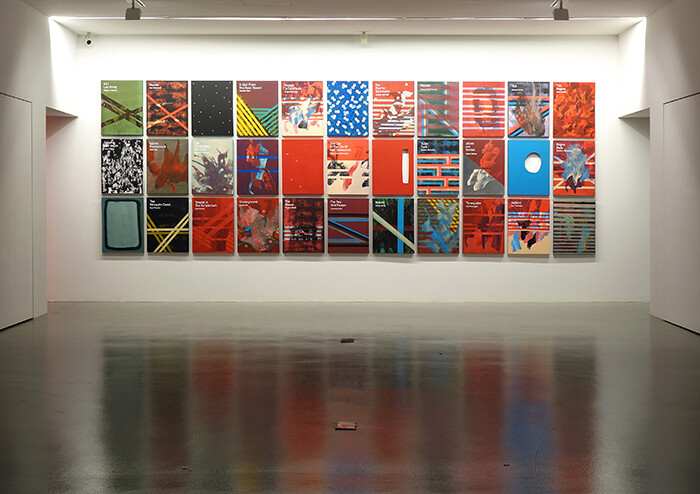With his latest deliberation on narrative, text, and the future, Heman Chong offers a handsome presentation of paintings, text pieces, and a found book in his new solo exhibition “Of Indeterminate Time Or Occurrence” at Singapore’s FOST Gallery. Greeting you on one wall is a series of small paintings—organized in a three-row, eleven-column grid—and opposite from them, like a kind of déjà vu, is a second set of 33 paintings. Left empty and unlit, the long space between the two walls emphasizes the paintings’ sheer numbers, technique, and execution. With each of Chong’s canvases being a viable abstract painting, and in light of his competent painterly gestures, a question arises: How does he reconcile his research-based practice, which values idea over form, with his painterly brush? In other words, how does the artist manage to have it both ways?
In this exhibition, Chong intersperses paintings from the “Cover (Versions)” series (2009–ongoing)—each one featuring a book title and author’s name against an abstract background, much like a book cover—among “wordless” canvases from his newer “Things That Remain Unwritten” series (2013–ongoing). Serving as fillers or breathers, the latter canvases offer relief from the otherwise didactic text panels on view, affording us a way to read the books “between the covers.” In contrast to his earlier work, One Hundred Years of Solitude (2008)—a large-scale, achromatic outdoor billboard based on the title of Colombian writer Gabriel García Márquez’s 1967 novel—each canvas in this exhibition is an understated, yet oddly agreeable introduction to the dark world of solitude. They are physically portable and enveloped by brightly colored gestures. A recurrent theme is the individual’s fight for survival amidst social marginalization and oppression. Wittgenstein’s Mistress / David Markson (2013), for example, refers to Markson’s 1988 novel about a woman who, despite her apparent madness, manages to convince all—including you, the reader—that she is the last person on earth.
Most of Chong’s book works, as well as his paintings, are only visible from the outside. However, his aesthetic becomes much more engaging when he allows for physical entry into the book, as seen in the exhibition’s strongest piece, After Bolaño (After Duchamp) (2014). Here, in homage to Marcel Duchamp’s Unhappy Readymade (1919)—an artwork consisting of instructions that Chong first learned about while reading 2666, Chilean author Roberto Bolaño’s 2004 novel—he clips a half-opened geometry book onto a string. Chong’s enactment of Duchamp’s piece, by way of Bolaño, makes an eloquent case for the existence of an alternate art history authored not by art historians, but fiction writers. It is as if he would like to remind us that even experts don’t know everything about their supposed area of expertise.
Chong’s works are at their best when they are couched in mystery and confusion. Rather than showing or telling, they point, leaving viewers to follow clues. Whether his work will resonate with viewers is not certain, or—as his show title suggests—“of indeterminate time or occurrence.” But when paradox is worn proudly as a badge of honor, it can get contrived. To this extent, his work Never / Again (2014) imparts a certain kind of truth about art, but this is done in a most tedious manner: through repetition. It consists of the words “NEVER” and “AGAIN” alternately flashing in neon lights on a wall. The piece presumes a false binary between the flashing words in order to argue for their complication, reflecting the paradox of art’s love of the new and inevitable indebtedness to the old. Never / Again becomes tiresome precisely because it relentlessly repeats its mantra; you instantly get the message even when you don’t necessarily agree with its premise.
Because Chong pursues an intellectually-driven practice, his ideal viewers are open-minded individuals, who shed their naiveté in favor of a greater sense of awareness about the way in which knowledge informs power. The Forer Effect (2008), for example, a text-based work meant as an epilogue to this show, could very well be read as the artist’s own personal statement. Applied to the wall with vinyl lettering, the phrases are appropriated from a 1948 experiment by American psychologist Bertram Forer, which demonstrated that when crafted in a generic enough manner, messages can simultaneously appeal to a vast number of people, as if the information was specifically tailored for them. By reproducing this text on the wall and presuming they have no previous knowledge of its origins, the artist makes his viewers conscious of information’s subliminal effects, especially in today’s world of interconnectivity.
But given that both the Forer effect and Chong’s work operate by engaging the viewer on an intellectual level, one must beware of treading the moral high ground. You could very well be moving from one prison to the next—from a well of ignorance to an ivory tower—because even the most informed reader is not immune to the pernicious effects of preconceived beliefs. In effect, what appeals to you can also manipulate you. “You have a need for other people to like and admire you, and yet, you tend to be critical of yourself,” the wall text observes. This describes almost every human being on earth! Our best response to these seductive words would be a mere shrug of the shoulders and two words of nonchalance: “… I guess.”








